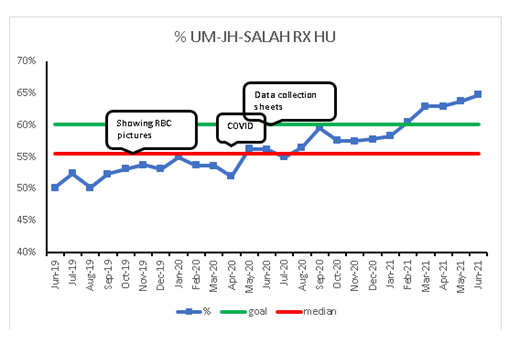Abstract
Background: "Education and Mentoring to Bring Access to Care for SCD (EMBRACE SCD)"--U1EMC31108-- is a multicenter study sponsored by HRSA in the US southeastern region, which focuses on extending knowledge about sickle cell disease (SCD) to hematology and primary care providers and to improve the care of children and adults with SCD. In Florida we aimed to improve access by increasing prescription (RX) rates of hydroxyurea (HU), by at least 10% from baseline in patients with sickle cell anemia.
Methods: Three SCD centers, assisted by three community-based organizations and with the support of two pediatricians with expertise in quality improvement (QI), were engaged in this QI project. The SCD centers are the University of Miami (UM), Salah Foundation at Broward Health and Johns Hopkins All Children's Hospital (JH). Data were abstracted locally and entered into REDCap by a central data manager. Run charts were created to assess data improvement. UM also assessed barriers using a parent/caregiver questionnaire administered at least 6 months after offering HU with the purpose of improving patient education and desire to take HU.
Results: Beginning in June 2019 until June 2021, center clinicians concentrated in identifying all patients who were eligible for HU (namely, children 9 months and older with hemoglobin SS and hemoglobin SB 0thalassemia who were not on chronic transfusions). As a group, 50.2% (N=263) of patients were on hydroxyurea at entry (range 35.4-62.4 % among the sites) from a total of 524 eligible patients. The main organizing activities which allowed for higher percent were having a center patient database (done March 2019), educating all providers in the centers about the importance of HU as disease-modifying therapy, having a unified protocol for the education of parents and/or patients about HU benefits, and using visual aids (pictures) of erythrocytes pre and post HU treatment. The QI consultants met virtually with the Florida EMBRACE team monthly beginning June 2020 to increase engagement and interest in participating in this QI activity. We implemented a data collection sheet to track medical records every month to determine whether we were capturing all eligible patients. As depicted in the run chart, we surpassed the QI goal by ending with 64.8% (N=343) prescription rate (range 48.0-85.0 %) from a total of 529 eligible patients.
From the 76 barrier assessment questionnaires given at UM, we identified 12 (15.8%) refusals. Seven of 12 refused because of fear of taking "chemotherapy", one because of fear of side effects, and four because their children's disease was considered mild. With further education, we decreased the refusals from 12 to 9.
Conclusion: A unified approach to a QI project was successful among several centers in Florida, increasing the prescription rate of hydroxyurea by 14.6% among patients with sickle cell anemia.
Acknowledgment: We acknowledge HRSA and region principal investigators for EMBRACE SCD Drs. Ify Osunkwo, Julie Kanter and John J. Strouse for their support in this work.
Alvarez: Forma Therapeutics: Membership on an entity's Board of Directors or advisory committees; GBT: Membership on an entity's Board of Directors or advisory committees. Clay: Novartis: Honoraria; GBT: Membership on an entity's Board of Directors or advisory committees.


This feature is available to Subscribers Only
Sign In or Create an Account Close Modal